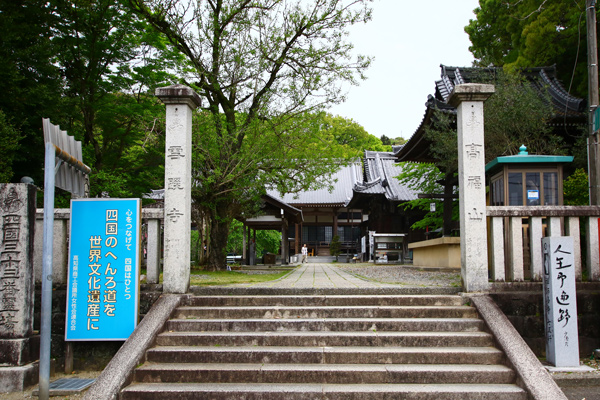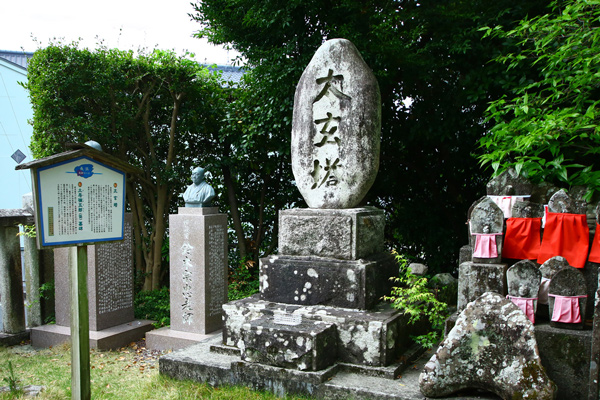The Shikoku Pilgrimage Temple Guide
Temple 33, Sekkeiji

Precinct map

History of the temple
Katsurahama Beach on Tosa Bay is known for its beautiful white sand and the view of the Moon reflected in the water. It is also famous for a bronze statue of Sakamoto Ryoma, a famous samurai from the closing days of the Tokugawa Shogunate. Sekkeiji is located about four kilometers west of this beach.
A legend explains the three characteristics of Sekkeiji.First, it is one of only two temples in the Shikoku Pilgrimage that belong to the Myoshinji school of Rinzai Buddhism. When it was founded by Kobo Daishi in 815 it was called Kofukuji and was in the Shingon sect. Later the name of the temple was changed to Keiunji. The temple was rebuilt by Chosokabe Motochika, a lord of Tosa (Kochi) during the Sengoku period (1467-1590). He invited the monk Geppo to be the chief priest of the temple. Geppo was from the Rinzai sect, Motochika's own sect. After Motochika's death, his fourth son Morichika succeeded him and the temple was designated as a family temple of the Chosokabe family. It was renamed Sekkeiji after Motochika's Buddhist name.
Second, Unkei, a famous Buddhist sculptor of the Kamakura period (1185-1333), and his eldest son Tankei stayed at this temple and carved Buddhist statues. Unkei carved the principal image of Yakushi Nyorai (Medicine Buddha) and the images of Nikko and Gekko Bosatsu, the bodhisattvas of the Sun and the Moon, which stand alongside. Tankei carved the images of Bishamonten (Vaishravana), Kichijo Tennyo (Kisshōten), and the cute little Zennishi Doji, posed cocking his head. This is the reason the temple was called Keiunji for a while. Together with statues of 12 generals cared by Unkei's disciples, these statues are designated National Important Cultural Properties.
Third, the temple is said to be the birthplace of Nangaku (Southern Learning). Tenshitsu, the head priest of the temple in the early Edo period (1603-1868) established Nangaku, an offshoot of Shushigaku (the Cheng–Zhu school). Many outstanding Confucian scholars, including Tanijichu and Nonaka Kenzan also came from this temple. Yamamoto Genpo, a notable Zen monk, was ordained at Seikeiji Temple. He completed the Shikoku Pilgrimage 17 times.
Highlights
Taigentō
This is a memorial tower for Yamamoto Tagen, the 17th head priest of Sekkeiji, who restored the temple after it was closed due to the haibutsu kishaku (the anti-Buddhist movement at the beginning of the Meiji era). He was also a teacher of the 18th priest, Genpō.
Genpōtō
This is a memorial tower for the 18th head priest, Yamamoto Genpō. When he was young, Genpō became nearly blind and made seven pilgrimages barefoot. On the way, he was so excited that he fell down on the path. Then Taigen rescued him and Genpō began working at the temple. Later he became known as the outstanding monk of the Showa era. He was consulted by Prime Minister Suzuki, the prime minister at the end of World War II (7 April to 17 August, 1945), on how to end the war. Genpō told him, "The emperor is a symbol. Japan should win by losing the war.” He is said to have written a letter to the prime minister that was connected with Emperor Showa's famous phrase, "By enduring the unendurable and suffering what is insufferable.”
Tomb of Nobuchika
Eldest son of Chosokabe Motochika. He died with his 700 men in Bungo (Oita) due to Toyotomi Hideyoshi's conquest of Kyushu.
Buddhist statues that are important cultural properties
Sixteen Buddhist statues that are important cultural properties and made by Unkei, Yukei, and others. Reservations are required to see these statues.

Annual Events
| February 3 | Setsubun Yakuyoke (Warding off evil)/Hannya Shingyo Hyakkan Dokkei (Reading 100 scrolls of sutras) |
| 8th day of the fourth month of the lunar calendar | Hana Matsuri (Buddha’s Birthday) |
| 1st Sunday in July | Bon Festival/Sotoba Memorial Service |
| 3rd Sunday in July | Anzan Koyasu Jizo Matsuri (Festival of Earth Treasury for safe delivery and childbirth) |
| 2nd or 3rd Sunday in October | Segaki (ritual for restless spirits) |
| December 31st | Joya no Kane (New Year’s Eve bell)/Soba (buckwheat noodles) Settai |
Details
Names: Kōfukuzan, Kōfukuin, Seikeiji
Denomination: Rinzai Sect ,Myoshinji school
Principal Image: Yakushi Nyorai
Founder: Kobo Daishi
Founded: 815
Access
Address: 857-3, Nagahama, Kochi City, Kochi 781-0270
Phone: 088-837-2233
Parking: 10 cars, 5 microbuses, 3 buses (6:00 a.m. to 6:00 p.m.)
Lodging: None
Official website: None
